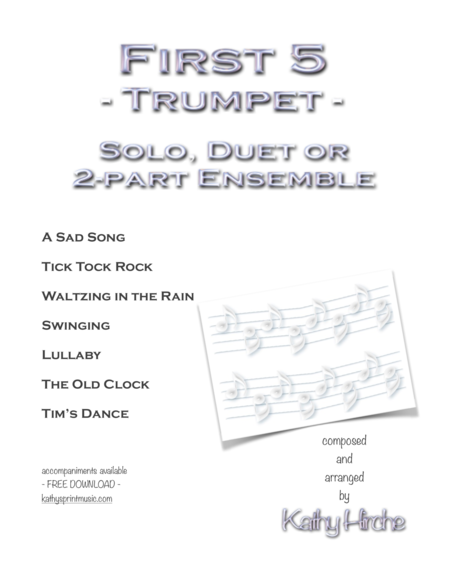Trumpet Duet Trumpet - Level 1 - Digital Download SKU: A0.819922 Composed by Kathy Hirche. Contemporary,Standards. Score. 14 pages. Kathy Hirche #428995. Published by Kathy Hirche (A0.819922). The First 5 series is suitable for elementary level performers of all ages. It provides seven pieces which are musically satisfying and fun to play without demanding more than basic technical ability and theoretical knowledge and the first five notes learned on the instrument. Pitches used: C D E F G (written range). Rhythmic values used: semibreve (whole-note), dotted minim (dotted half-note), minim (half-note), crotchet (quarter note), quavers (eighth-notes). Quavers (eighth-notes) appear only in groups of 2 or 4. Articulations/signs used: staccato, accent, slur, tie, repeat, 1st and 2nd time endings. Each piece may be performed as a Solo (use Part 1), Duet or 2-part Ensemble. All pieces in the First 5 series are in the same concert key, enabling performances with various combinations of these instruments: Flute, Clarinet, Alto Sax, Tenor Sax, Trumpet, Trombone, Euphonium. Accompaniments for each piece are available as FREE MP3 FILES. These can be downloaded from kathysprintmusic.com. The audio sample provided here consists of excerpts of all seven pieces: A Sad Song, Tick Tock Rock, Waltzing in the Rain, Swinging, Lullaby, The Old Clock, Tim's Dance. ISMN 9790-9009-679-1-6. Serie Los Primeros 5. Solo, Ensamble de 2 partes, duo - la serie de los Primeros 5 es adecuada para intérpretes Nivel Elemental de todas las edades. Contiene 7 piezas que son musicalmente satisfactorios, divertidas de tocar sin demandar de una habilidad técnica mas allá de un conocimiento teórico básico dado al tocar las primeras 5 notas del instrumento. Los tonos usados son: C, D, E, F, G. Los valores rÃtmicos usados son: semibreve (nota entera), minim apuntillarÃa (media nota con punto), minim (media nota), cuarto de nota o negrita, corchea (octavos de nota). Los octavos de nota aparecen solo en grupos de 2 o de 4. Los sÃmbolos/articulaciones usadas son: staccato, acento, legato, repetición, fin de primer y segundo tiempo. Cada pieza puede ser tocada como solista (usando la Parte 1), como un cueto o como ensamble de 2 partes. Todas las piezas en la seria de los Primeros 5 están en la misma clave de concierto, permitiendo a los músicos ejecutarlas con diversas combinaciones de estos instrumentos: falta, clarinete, alto saxofón, saxofón tenor, trompeta, trombon, eufónico. Los acompañamientos para cada pieza se encuentran como ARCHIVOS GRATIS de MP3 que se pueden descargar desde el sitio kathysprintmusic.com La muestra de audio que se proporciona aquà contiene fragmentos de las siete piezas: una canción triste , tick tick rock, bailando vals en la lluvia, swinging, canción de cuna, el reloj viejo, el baile de Tim.
